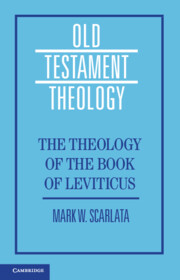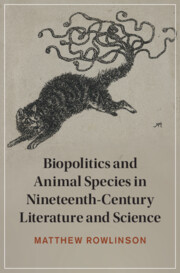Refine search
Actions for selected content:
118 results
Chapter 2 - Sin, Sacrifice, and Atonement (Leviticus 1–7, 16)
-
- Book:
- The Theology of the Book of Leviticus
- Published online:
- 18 July 2025
- Print publication:
- 07 August 2025, pp 32-82
-
- Chapter
- Export citation
Chapter 3 - Purity and Impurity (Leviticus 11–15)
-
- Book:
- The Theology of the Book of Leviticus
- Published online:
- 18 July 2025
- Print publication:
- 07 August 2025, pp 83-113
-
- Chapter
- Export citation

The Theology of the Book of Leviticus
-
- Published online:
- 18 July 2025
- Print publication:
- 07 August 2025
22 - Mixed Race, Mixed Marriage, and Jewish Christians
-
-
- Book:
- The Cambridge History of the Holocaust
- Published online:
- 16 May 2025
- Print publication:
- 12 June 2025, pp 365-381
-
- Chapter
- Export citation
Chapter 3 - Flow Cytometry of Normal Blood, Bone Marrow and Lymphatic Tissue
-
-
- Book:
- Multiparameter Flow Cytometry in the Diagnosis of Hematologic Malignancies
- Published online:
- 30 January 2025
- Print publication:
- 20 February 2025, pp 36-58
-
- Chapter
- Export citation
8 - Rites of the Bridal Chamber
- from Part III - Marriage Rites in Byzantine Liturgical Manuscripts
-
- Book:
- Marriage in Byzantium
- Published online:
- 01 May 2025
- Print publication:
- 23 January 2025, pp 310-351
-
- Chapter
- Export citation
Change the Meaning, Save More Lives: Why Changing the Meaning of Commercial Compensated Collections of Substances of Human Origin Is Both Feasible and Preferable to Banning the Practice for Fear of Commodification
-
- Journal:
- Social Philosophy and Policy / Volume 41 / Issue 2 / Winter 2024
- Published online by Cambridge University Press:
- 06 February 2025, pp. 527-545
- Print publication:
- Winter 2024
-
- Article
-
- You have access
- Open access
- HTML
- Export citation
HIPPOCRATES, ON REGIMEN 49.2
-
- Journal:
- The Classical Quarterly / Volume 74 / Issue 2 / December 2024
- Published online by Cambridge University Press:
- 04 April 2025, pp. 774-776
- Print publication:
- December 2024
-
- Article
-
- You have access
- Open access
- HTML
- Export citation
Chapter 6 - Vascular Dementia
- from Section 2 - Diagnosing Different Types of Dementia
-
- Book:
- The Neuropsychology of Dementia
- Published online:
- 25 October 2024
- Print publication:
- 17 October 2024, pp 74-85
-
- Chapter
- Export citation
Chapter 56 - Infection Control
- from Section 5 - Patient Management
-
- Book:
- Clinical and Diagnostic Virology
- Published online:
- 11 April 2024
- Print publication:
- 18 April 2024, pp 282-285
-
- Chapter
- Export citation
Chapter 6 - Knowing Nature as a God
-
- Book:
- Reconstructing Empedocles' Thought
- Published online:
- 01 February 2024
- Print publication:
- 08 February 2024, pp 246-306
-
- Chapter
- Export citation

Biopolitics and Animal Species in Nineteenth-Century Literature and Science
-
- Published online:
- 11 January 2024
- Print publication:
- 01 February 2024
Chapter 3 - The Lustful Oblivion of Widowhood in The Insatiate Countess
- from Part I - Ars memoriae, ars amatoria
-
-
- Book:
- Memory and Affect in Shakespeare's England
- Published online:
- 07 June 2023
- Print publication:
- 27 July 2023, pp 68-86
-
- Chapter
- Export citation
Chapter 11 - The Mechanics of Galen’s Theory of Nutrition
- from Part III - Towards the Mechanization of the Human Body
-
-
- Book:
- Body and Machine in Classical Antiquity
- Published online:
- 13 July 2023
- Print publication:
- 27 July 2023, pp 262-295
-
- Chapter
- Export citation
Chapter 19 - The Endocannabinoid System in Schizophrenia
- from Part VI - Cannabinoids and Schizophrenia: Aetiopathology and Treatment Implications
-
-
- Book:
- Marijuana and Madness
- Published online:
- 12 May 2023
- Print publication:
- 01 June 2023, pp 189-199
-
- Chapter
- Export citation
Chapter 29 - Fundamentals of Fluid and Electrolyte Balance during Surgery
-
-
- Book:
- Fundamentals of Operating Department Practice
- Published online:
- 18 August 2022
- Print publication:
- 08 September 2022, pp 322-333
-
- Chapter
- Export citation
Chapter 17 - Haemodynamic Monitoring
-
-
- Book:
- Fundamentals of Operating Department Practice
- Published online:
- 18 August 2022
- Print publication:
- 08 September 2022, pp 180-190
-
- Chapter
- Export citation
Introduction
-
-
- Book:
- The Cambridge Companion to American Horror
- Published online:
- 21 July 2022
- Print publication:
- 04 August 2022, pp 1-12
-
- Chapter
- Export citation
20 - Circulation and the New Physiology
- from Part III - Problems and Controversies
-
-
- Book:
- The Cambridge History of Philosophy of the Scientific Revolution
- Published online:
- 14 January 2022
- Print publication:
- 06 January 2022, pp 369-386
-
- Chapter
- Export citation
Detecting SARS-CoV-2 Orf3a and E ion channel activity in COVID-19 blood samples
-
- Journal:
- Journal of Clinical and Translational Science / Volume 5 / Issue 1 / 2021
- Published online by Cambridge University Press:
- 14 September 2021, e196
-
- Article
-
- You have access
- Open access
- HTML
- Export citation
